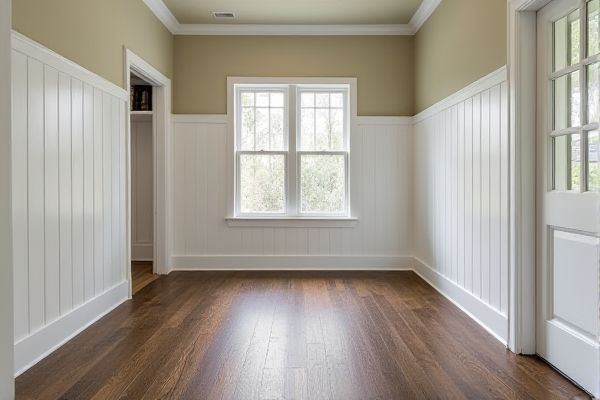
Painted beadboard offers a crisp, clean look that brightens your mudroom and allows for easy customization with any color scheme, while stained beadboard highlights the natural wood grain, providing a warm, rustic ambiance that adds character to the space. Explore the rest of the article to discover which option best suits your style and practical needs for your mudroom.
Table of Comparison
| Feature | Painted Beadboard | Stained Beadboard |
|---|---|---|
| Appearance | Bright, smooth, consistent color | Natural wood grain visible, rich tone |
| Durability | Resistant to moisture and stains with proper paint | Durable but may require periodic re-staining |
| Maintenance | Easy to clean, occasional repainting needed | Needs regular sealing to protect wood |
| Installation | Requires priming before painting | Pre-stained boards available, simpler installation |
| Cost | Generally lower initial cost | Higher upfront cost due to stain and sealants |
| Best For | Modern, bright mudrooms with frequent cleaning | Traditional, rustic mudrooms highlighting wood texture |
Introduction: Painted vs Stained Beadboard in Mudrooms
Painted beadboard in mudrooms offers a smooth, uniform finish that brightens the space and provides a versatile backdrop for various decor styles. Stained beadboard highlights the natural wood grain, adding warmth and a rustic charm that complements traditional or farmhouse designs. Your choice depends on the desired aesthetic and maintenance preferences, with paint offering easier cleaning and stain showcasing wood's organic texture.
Aesthetic Differences: Color, Texture, and Style
Painted beadboard in a mudroom offers a smooth, uniform color that brightens the space and complements modern or traditional decor with a clean, polished finish. Stained beadboard highlights the natural wood grain and texture, adding warmth and rustic charm suited to farmhouse or vintage styles. The choice between painted and stained beadboard significantly influences the mudroom's overall aesthetic by balancing color vibrancy against organic texture and style authenticity.
Durability and Maintenance Needs
Painted beadboard in a mudroom offers enhanced durability against moisture and stains due to its sealed surface, requiring regular cleaning and occasional touch-ups to maintain its appearance. Stained beadboard showcases the natural wood grain and typically demands more frequent maintenance, including resealing and refinishing to protect against water damage and wear. Both finishes require proper care, but painted beadboard generally provides a longer-lasting, low-maintenance option for high-traffic, moisture-prone spaces like mudrooms.
Cost Comparison: Materials and Labor
Painted beadboard typically costs less in materials but may require more frequent maintenance and repainting over time, impacting long-term expenses. Stained beadboard involves higher upfront material costs, especially for premium stains and sealants, but offers greater durability and easier upkeep, reducing labor costs in the long run. Your choice depends on balancing initial budget constraints with desired maintenance frequency and overall aesthetic goals.
Best Paints and Stains for Mudroom Beadboard
For mudroom beadboard, water-based acrylic latex paints with a semi-gloss or satin finish offer durable protection against moisture and frequent cleaning while providing a smooth, vibrant appearance. High-quality oil-based stains enhance the natural wood grain, creating a rich, warm aesthetic that withstands wear in high-traffic areas. Brands like Benjamin Moore Aura for paints and Minwax Wood Finish for stains are highly recommended for their longevity and resistance to moisture in mudroom environments.
Moisture Resistance and Longevity
Painted beadboard in mudrooms offers superior moisture resistance due to its sealed surface, preventing water absorption and reducing the risk of warping or mold growth. Stained beadboard, while showcasing natural wood grain, typically requires a protective clear finish to enhance durability against humidity and daily wear. Choosing high-quality paint or stain with moisture-resistant properties significantly impacts the longevity and maintenance of beadboard in moisture-prone areas like mudrooms.
Customization Options: Finishes and Patterns
Painted beadboard offers you a wide range of customization options with an array of colors and finishes, allowing for sleek, uniform looks or vibrant, bold statements that can complement any mudroom style. Stained beadboard highlights the natural grain and texture of the wood, providing rich, warm tones and classic patterns that enhance rustic or traditional designs with unique wood variations. Both finishes allow for creative pattern choices such as vertical, horizontal, or diagonal beadboard installation, tailoring the mudroom's aesthetic to suit your personal taste and home's character.
Installation Process: Painted vs Stained Beadboard
Painted beadboard requires priming and multiple coats of paint, demanding careful masking and drying time to ensure a smooth, durable finish during installation. Stained beadboard involves sanding, applying stain evenly, and sealing with a clear coat, which emphasizes the wood grain and offers a natural look but requires precise application to avoid blotching. Both methods necessitate proper surface preparation and curing time, with painted beadboard often preferred for a uniform, customizable color and stained beadboard chosen for highlighting wood texture in mudroom installations.
Cleaning and Upkeep Tips for Mudroom Beadboard
Painted beadboard in your mudroom offers a smooth surface that is easy to wipe down with mild soap and water, making daily cleaning simple and effective. Stained beadboard, while showcasing natural wood grain, may require periodic sealing to prevent moisture damage and maintain its finish, especially in high-traffic or damp environments. To keep either option looking fresh, regularly dust the grooves and immediately address spills to prevent staining or warping.
Which Option is Best for Your Mudroom?
Painted beadboard offers a bright, clean look that can easily match various mudroom designs and hides minor imperfections well, making it ideal for high-traffic areas prone to wear and dirt. Stained beadboard showcases the natural wood grain, providing a warm, rustic charm that adds character and can withstand moisture better if sealed properly, which suits mudrooms with heavier use or rustic aesthetics. Choosing the best option depends on your desired style--painted for a sleek, modern feel or stained for a natural, durable finish--and the level of maintenance you're comfortable with in your mudroom.
 homyna.com
homyna.com